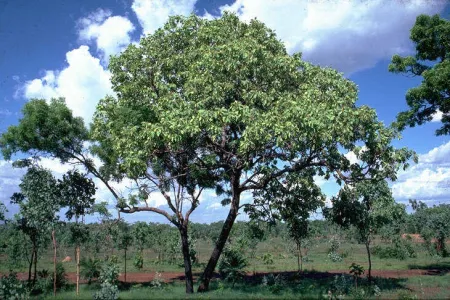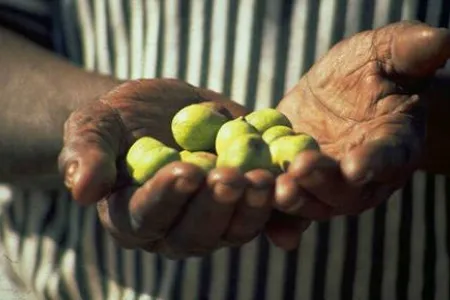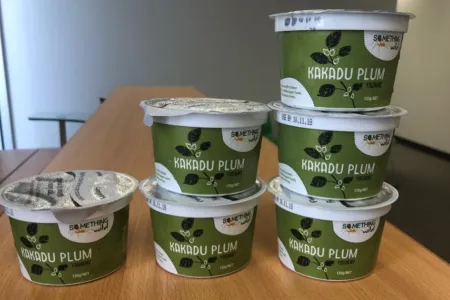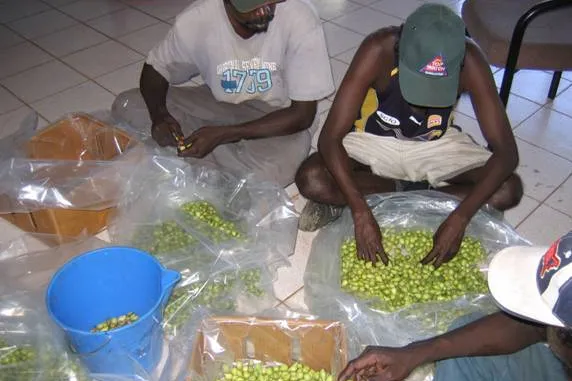Introduction
Terminalia ferdinandiana
Common names: Kakadu Plum (KP), Billy Goat Plum (NT); Gubinge (Broome); MiMarrarl (Wadeye)
- Family: Combretaceae, Genus: Terminalia
- 200 species globally,
- 50 have commercial uses e.g., tannins, timber; nutritional and/or medicinal use
- endemic to Australia, Top End of the NT and the Kimberley, WA
- one of 29 species in Australia
- small to moderate sized, semi-deciduous (drops its leaves) tree
Kakadu Plum is an emerging industry in remote Aboriginal communities that has the potential for significant growth. The fruit of Kakadu Plum is extremely rich in vitamin C, the leaf high in ellagic acid and its bark has been traditionally used in bush medicine. The Kakadu Plum industry is therefore strongly aligned with Aboriginal cultural values, and it can be owned and directed by Aboriginal communities.
Terminalia ferdinandiana is an endemic, native species of Australia which has exceptional biochemical properties in the leaf and fruit giving it commercial potential which, to be realised, requires research and development priority. Aboriginal people have used this species for customary purposes for thousands of years and many of its properties have been quantified by laboratory chemical analysis and are recorded in the public domain (Isaacs, 1987; Lindsay et al. 2001; Puruntatameri et al. 2001; Raymond et al. 1999). Subsequently, there is commercial demand from the food and beverage, cosmetic and nutraceutical sectors. This demand has been partially met through a variety of fragmented supply chains which have continued to grow with further research findings and new commercial applications. Supply networks and models of governance have been developed and trialed with some groups forming cooperatives to try and meet increased commercial demand.
The current situation is that there is a rapidly increasing demand for the fruit and still relatively undeveloped and fragmented supply chains. To meet demand requires a substantial amount of work on identifying the efficiencies of supply chains of T. ferdinandiana products so there is a better understanding of the mechanisms and actors and how they can be improved. The markets interested in T. ferdinandiana products are diverse, but many require a high end, high volume product so quality, consistency and traceability are extremely important.
Properties of fruit and leaf - naturally occurring plant chemicals (phytochemical)
Ascorbic acid (vitamin C)
- highest of any fruit in the world (>17% dry weight) (Williams et al. 2014)
- pharmaceutical, nutrition industry (Mohanty and Cock, 2012)
Ellagic acid
- antioxidant - targets disease causing free radical (cancer) (Cock and Mohanty, 2011)
- prevents aging of skin - reduces oxidative stress - reduces heart and liver disease
- anti-microbial properties
Properties of Kakadu plum compared to other fruit (PDF, 346.88 KB) (Prof. Yasmina Sultanbawa, University of Queensland)
Reasons for high levels
- chemical defence against herbivores
- response to high UV to protect leaf cells
Recorded Aboriginal use
- fruit used for medicine, food
- bark used to treat skin disorders, infections (anti-bacterial) (Issaacs 1987)
Commercial application
- pharmaceutical,
- nutraceutical,
- preservative,
- cosmetic industries
Research Partners and Collaborators
Research: Research Institute for Environment and Livelihoods (RIEL), Charles Darwin University – Dr Penny Wurm (penny.wurm@cdu.edu.au); Dr Julian Gorman (CDU Adjunct Researcher j.gorman@massey.ac.nz)
Research: Queensland Alliance for Agriculture & Food Innovation (QAAFI) University of Queensland – Professor Yasmina Sultanbawa
Industry: Thamarrurr Development Corporation – Dr Chris Brady; Scott McIntyre
Industry: North Australian Aboriginal Kakadu Plum Alliance
NT Government: NT Department of Industry, Tourism and Trade – Dr Sohail Mazhar; Dr Salman Quddus
Training: North Region TAFE, WA – Kim Courtenay
Relevant Publications and outputs
Peer reviewed books
Whitehead, P. J., Gorman, J., Griffiths, A.D., Wightman, G., Massarella, H., and Altman, J. (2006). Feasibility of local, small scale commercial native plant harvests for indigenous communities. Joint Venture Agro-forestry Program, Canberra. 186 pp.
Peer reviewed book chapters
Gorman, J., Brady, C. and Courtenay, K. (2016). Commercialisation of Terminalia ferdinandiana Exell. in northern Australia. In: Y. Sultanbawa and F. Sultanbawa (eds), Australian Native Plants: Cultivation and Uses in Alternative Medicine and the Food Industry, pg. 89-104, CRC Press/Taylor & Francis Group.
Peer reviewed journal articles
Gorman J., Ennis G., Wurm P., Bentivoglio M., Brady C. (2023). Aboriginal Community Views about a Native Plant-Based Enterprise Development in Northern Australia. Land 12(5):1096. https://doi.org/10.3390/land12051096
Gorman, J.T. and Ennis, G. (2022). Community engagement in Aboriginal enterprise development – Kakadu plum as a case analysis. Journal of Rural Studies 92, 109-119. https://doi.org/10.1016/j.jrurstud.2022.03.020
Pearson, D., Gorman, J., and Aspinall, R. (2022). "Multiple Roles for Landscape Ecology in Future Farming Systems: An Editorial Overview" Land 11(2), 288. https://doi.org/10.3390/land11020288
Chaliha, M., Dao Thi Phan, A., Cao, S., Li, Q., Gorman, J., Sultanbawa, Y. and Cozzolino, D. (2020). Antimicrobial activity, total phenolic and ascorbic acid content of Terminalia ferdinandiana leaves at various stages of maturity. Current Research in Nutrition and Food Science, 8 (3).
Gorman, J.T.; Bentivoglio, M.; Brady, C.; Wurm, P.; Vemuri, S. and Sultanbawa, Y. (2020). Complexities in developing Australian Aboriginal enterprises based on natural resources.Rangeland Journal, 42(2), 113-128.
Gorman, J., Pearson, D. and Wurm, P. (2020). Old ways, new ways – scaling up from customary use of plant products to commercial harvest taking a multifunctional, landscape approach. Land, 9(5), 171.
Gorman J, Markones H., Lawes M. J. (2020) Understanding the reproductive biology of Terminalia ferdinandiana for improved fruit yields. Australian Journal of Botany, 67(8), 630-637.
Gorman, J., Wurm, P.A.S., Vemuri, S., Brady, C., Sultanbawa, Y. (2019) Kakadu Plum (Terminalia ferdinandiana) as a Sustainable Indigenous Agribusiness. Economic Botany 74(1), 74-91.
Cunningham, A.B.; Courtenay, K.; Gorman, J.T. and Garnett, S. (2009). Eco-enterprises and Kakadu Plum (Terminalia ferdinandiana): “best laid plans” and Australian policy lessons. In: Economic Botany 63(1): 16-28.
Peer reviewed conference proceeding
Gorman, J., Brady, C. and Sultanbawa, Y. (2018). ‘Looking after country’ through wildlife utilisation In: (Ed. Baxter, G., N. Finch and Murray, P.) Advances in conservation through sustainable use of wildlife. Proceedings of a conference held in Brisbane, Australia in 2016. Pp. 235-239.
Government Management Plan
Gorman, J., Brady, C., Clancy, T. (2019). Management Program for Terminalia ferdinandiana (Kakadu Plum) in the Northern Territory of Australia 2018-2022. Northern Territory Department of Environment and Natural Resources, Northern Territory Government.
Television appearance:
ABC, 2018. Feeding Australia: Foods of tomorrow. Kakadu plum. Catalyst. Released 14 August 2018. https://www.podchaser.com/podcasts/catalyst-64487/episodes/feeding-australia-foods-of-tom-39949260



